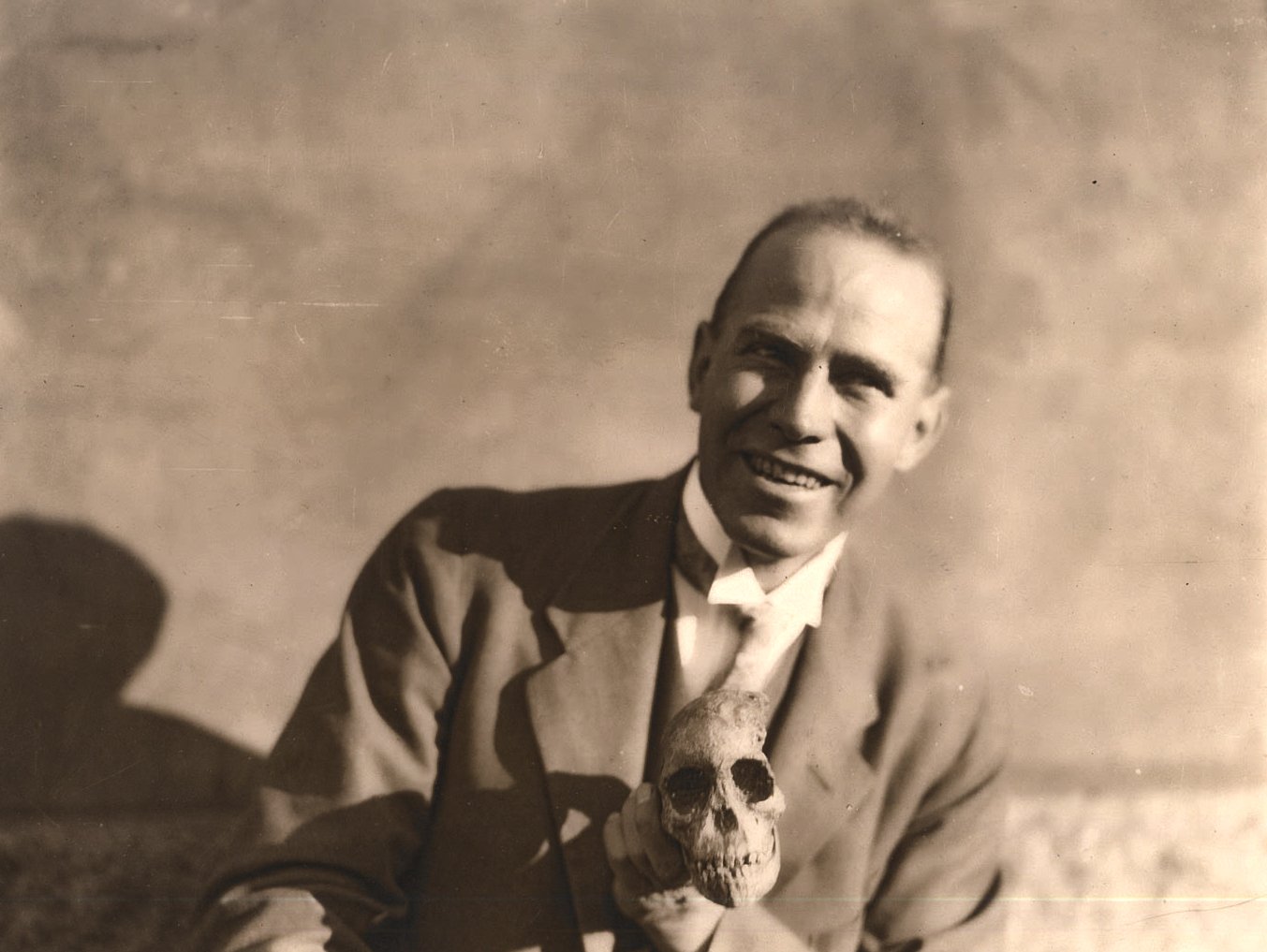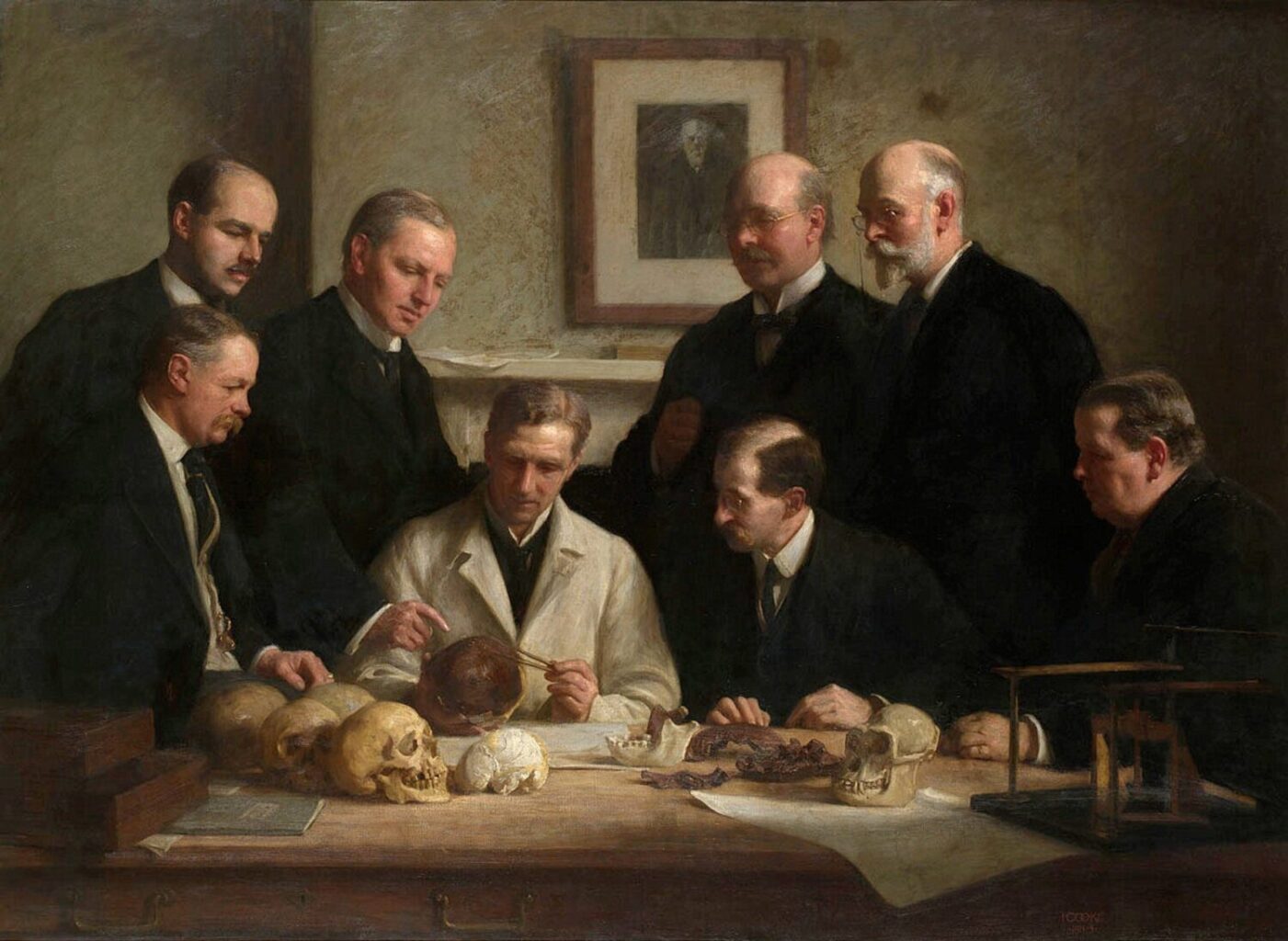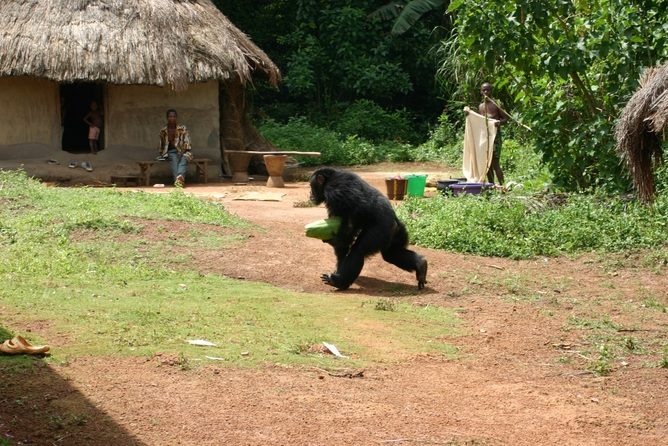From the Archive | Guest Post | Video

By Dean Falk, Florida State University
Raymond Arthur Dart (1893-1988) announced, described, and named the first discovery of an Australopithecine in the February 7, 1925 issue of Nature. The now iconic specimen consisted of a partial fossilized face, jaw, and cast of the interior of the braincase (endocast) of a young child from Taung (then called Taungs), which Dart assigned to a new genus and species (Australopithecus africanus).
Dart’s 1959 reminiscence about the day he first set eyes on the specimen is enthralling:
“My Virginia-born wife Dora… had noticed the men with the boxes and rushed in to me in something of a panic. “I suppose those are the fossils you’ve been expecting,” she said. “Why on earth did they have to arrive today of all days?” She fixed me with a business-like eye. “Now Raymond,” she pleaded, “the guests will start arriving shortly and you can’t go delving in all that rubble until the wedding [we are attending is] over.”… As soon as my wife had left… I tore the hated collar off and dashed out to take delivery of the boxes. Impatiently I wrestled with the lid of the second box… little guessing that from this crate was to emerge a face that would look out on the world after an age-long sleep… As soon as I removed the lid a thrill of excitement shot through me. On the very top of the rock heap was what was undoubtedly an endocranial cast or mold of the interior of the skull….I stood in the shade holding the brain as greedily as any miser hugs his gold… Here, I was certain, was one of the most significant finds ever made in the history of anthropology.”
Dart, R. A., with Craig, D. 1959. Adventures with the Missing Link. New York: Harper, quotation from p. 4-6.
Dart turned out to be right about the significance of his find. On November 7, 2019, Nature commemorated its 150th anniversary by naming ten key papers from its archives and Dart’s paper was among them. As he detailed in 1925, the specimen revealed a combination of apelike and humanlike features from a bipedal “man-ape” (his term) that appeared to be an unprecedented evolutionary intermediary between apes and humans. Further, the discovery’s location was consistent with Darwin’s hypothesis that Africa was the cradle of humanity, which was opposed to the then widespread belief that human ancestors originated either in Asia (Pithecanthropus erectus) or England (the fraudulent Piltdown Man). Dart’s claims also went against fundamentalist religious beliefs about human origins, which were gaining ground in America and abroad. Indeed, the infamous Scopes monkey trial took place in Dayton, Tennessee less than half a year after Taung’s announcement in Nature.
Dart had grown up on a cattle farm in Australia in a pioneer family of devote Baptists and Methodists but, like Charles Darwin and Louis Leakey, developed into an intellectual who eventually came to see discrepancies between fundamentalist beliefs and facts. Nonetheless, Dart retained many of the values in which he was raised, including that of treating his fellow human beings kindly. His generosity and regard for others are evident in his lecture by the extent to which he credited discoveries of other people, including a female student, Josephine Salmons, who sparked his desire to find endocasts and early primatologists who did the first research on great apes but never became well known to the public.
Dart’s 1925 publication received immediate worldwide acclaim as accolades rolled into South Africa from colleagues and politicians. But the honeymoon did not last long. In a matter of weeks, the accolades turned to disbelief, cynicism, and scolding, not just from members of the clergy and public, but also from Dart’s esteemed colleagues in London with whom he had trained and who were recognized as the crème de la-crème of paleoanthropology. Dart was deeply wounded by their criticism and even withdrew from paleoanthropology for some years until a younger colleague, Philip Tobias (1925-2012), enticed him back into the fold in 1945 with a new site that was likely to yield australopithecine fossils (Makapansgat). It also helped that Dart’s friend, the Scottish physician Robert Broom whom he mentioned in the lecture, discovered numerous additional australopithecines between 1936 and 1949. In his 1973 lecture Dart reveals that he was unhappy when his mentors in London (including Grafton Elliot Smith and Sir Arthur Keith) shipped him off to South Africa to become chair of the anatomy department at the newly formed University of Witwatersrand (WITS) in 1923.
However, not one to bear grudges, he refrained from noting that these same colleagues later scorned his announcement and interpretation of Taung, including the suggestion that Australopithecus, rather than Piltdown Man whom they favored, eventually gave rise to Homo. As Robert Broom wrote in 1950:
“It makes one rub one’s eyes. Here was a man who had made one of the greatest discoveries in the world’s history—a discovery that may yet rank in importance with Darwin’s Origin of Species; and English culture treats him as if he had been a naughty schoolboy. I was never able to discover what were Professor Dart’s offenses. Presumably the most serious was that when he found a very important skull he did not immediately send it off to the British Museum, where it would have been examined by an “expert” and probably described 10 years later, but boldly described it himself, and published an account within a few weeks of the discovery.”
Broom, R. 1950. Finding The Missing Link. London: Watts & Company, quotation from p. 27.

I learned how badly Dart had been treated by the “Piltdown Committee” when I visited the University of Witwatersrand Archives in Johannesburg in 2008 where I was allowed to read his unpublished professional materials and personal correspondence. It was clear from his private letters that Dart suffered terribly because of his London colleagues’ negative reaction to his discovery. To my utter astonishment, the repository held a 269-page unpublished manuscript that Dart spent four years writing, which provided extensive information about Taung. Dart wrote the monograph, titled “Australopithecus africanus: And His Place in Human Nature”, at least partly in response to his critics. The manuscript provided a treasure trove of information about the bones, teeth, and endocast of Taung and well as discussions of the relevant geology and “Africa as the cradle of pre-man.” Dart completed the monograph in 1929 and asked his mentor, Elliot Smith, to submit it on his behalf to the Royal Society of London for consideration for publication. (Smith was a Fellow of the society, so this was appropriate.) The manuscript was rejected by the Royal Society the following year and, as I have argued elsewhere, this was likely because Smith and anonymous reviewers were unhappy about the implications of Dart’s discovery for their theory that Piltdown Man gave rise to modern humans. (It would be over two decades before Piltdown was revealed to be a hoax.) Dart was discouraged by the rejection and set the manuscript aside thinking he might find a publisher at some later date. That never happened, however, and as far as I know ,this remarkable monograph still sits unpublished in the WITS archives.
This is a shame because, had it been published, Dart’s monograph might have changed the trajectory of future studies of paleoneurology, the study of hominin brain evolution. In his 1973 lecture, Dart briefly mentioned two grooves on the surface of the brain (he called them “sulci or depressions”) that he identified on the Taung endocast, although he didn’t name them (as is clear from his 1925 paper and 1929 monograph, he thought they represented the so-called lunate sulcus and the superior temporal sulcus). He also didn’t discuss the great significance he attributed to these two features in his 1925 article. Nor did he mention that his identification of them was the subject of intense controversy when Taung was announced as, indeed, they still are today. Dart’s 1925 discussion of these two features on Taung’s endocast supported the idea of Elliot Smith, whom Dart refers to in his lecture as “my old teacher in London,” that hominin brains evolved in a “mosaic” fashion, with the posterior regions (temporoparieto-occipital cortex) expanding before the frontal regions. Remarkably, in addition to these two sulci, Dart illustrated and identified 14 others on the Taung endocast in his unpublished monograph!

Happily, by the time 80-year-old Dart delivered his lecture (“The Discovery of Australopithecus and Its Implications”) at the Louis Leakey Memorial Symposium in 1973, most of the scientific world had come to accept Dart’s interpretation of Taung as representing a previously unknown small-brained bipedal hominin (as they are now called) in a new genus that he named (Australopithecus), which originated and evolved long ago in Africa. The field also accepted that our own genus (Homo) eventually stemmed from one of the australopithecine species, although paleoanthropologists are still trying to work out which one. Clearly, Dart’s 1925 paper in Nature deserved the honor of being included in the top ten papers published during that remarkable journal’s first 150 years.
Watch Dr. Zeray Alemseged’s commentary on Dr. Raymond Dart’s lecture and the original footage of Dart’s lecture from 1973:
Dr. Dean Falk is an evolutionary anthropologist who lives in Tallahassee, Florida where she is the Hale G. Smith Professor of Anthropology and a Distinguished Research Professor at Florida State University. She has taught anatomy and anthropology courses at several universities, and her research has taken her to Africa, Europe, and Asia. Much of her work focuses on the evolution of the human brain (paleoneurology) and the associated emergence of language, music, art, and science. Falk publishes scientific and popular books and articles, and lectures to both academic and public audiences.



